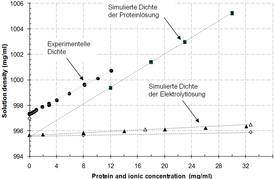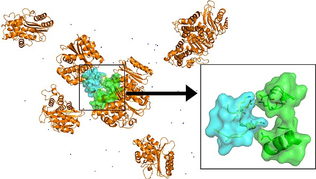Results
Simulation of Protein Solutions
In the initial experiments, modeling of realistic protein solutions was one major topic. Therefore, lactamases were chosen as model protein and simulation systems were designed with a total of 8 proteins and varying box size and amount of water molecules.
The simulation boxes consisted of 8 lactamases and water molecules as solvent, with a total of 302000 atoms. The protein concentration in this box was 110mg/ml and the density of the protein solution was 1.004 g/ml. In the following steps, the number of proteins was kept while the box size and the amount of water molecules were increased to reach realistic protein concentrations (Fig. 1). The observed protein contacts (Fig.2) showed that very large systems with box sizes of more than 250 A side length are necessary to achieve independent protein movement.
|
|
|
Hydration of Proteins
|
|
In this subproject, the hydration of Candida antarctica lipase B was investigated by performing gas phase experiments and simulations. The amount of water molecules was varied in both the experiments and the simulations and the number of free water molecules was measured.
All simulations and experiments were performed with CALB as protein and under control of the water activity. It was shown that forming of water networks is strongly dependent of the water activity which could also be shown by experiments in the gas phase reactor. [1]. Both simulation and experiment used argon as carrier gas. At low water activity several water binding sites could be identified (Fig. 3). At water activity of aw=0.5 a stable water network was formed by 311 water molecules on the surface of the lipase. A further increase of the water activity led to a binding of several water layers on the protein surface. With 1600 bound molecules, the layers became unstable and a droplet was formed. Additionally, an increase of the flexibility of the substrate binding pocket was found, while the overall flexibility showed no changes.




